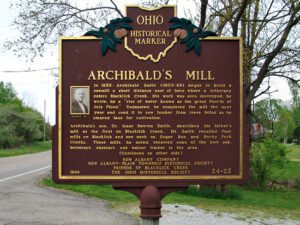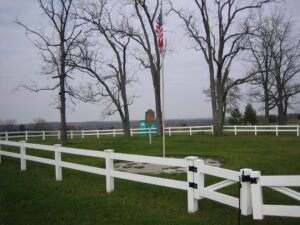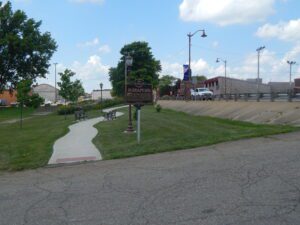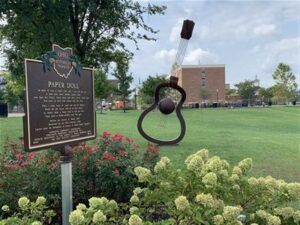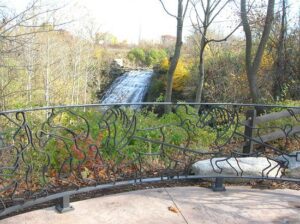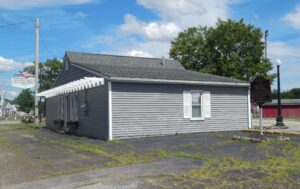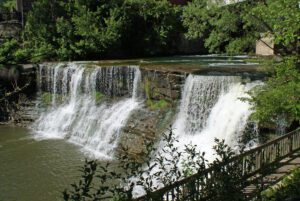, OH
In 1833, Archibald Smith (1803-83) began to build a sawmill a short distance east of here where a tributary enters Blacklick Creek. His work was soon destroyed, he wrote, by a “rise of water known as the great Fourth of July Flood.” Undaunted, he completed the mill the next year and used it to saw lumber from trees felled as he cleared land for cultivation. Archibald’s son, Dr. Isaac Newton Smith, described his father’s mill as the first on Blacklick Creek. Dr. Smith recalled four mills on Blacklick and one each on Sugar Run and Rocky Fork Creeks. These mills, he noted, received some of the best oak, butternut, chestnut, and walnut timber in the area. (Continued on other side)
, OH
A cemetery was established on the site in 1811 and became the final resting place for many of the area’s early pioneer families. The Hanover Township Trustees obtained title to the land in 1823 from John and Anna Farnsworth, and it was expanded for additional plots in 1879. Unfortunately many burials remain unmarked or can be located only by primitive limestone markers above them. The oldest readable headstone is dated 1816. (continued on the other side)
, OH
The village of Gates Mills derives its name from its founder, Holsey Gates, and from the importance of mills in the agricultural community. In 1826, the year of Gates Mills’ founding, a sawmill was constructed to increase the lumber supply and attract new settlers. In the following year, a rake factory was established, and by 1829 a gristmill was in operation. The Chagrin River was dammed to create a millrace that regulated the flow of water to the wheels that powered the mills. Shops and houses encircled the mills, which were the center of industry in Gates Mills.
, OH
Christian Deardorff (1781-1851) with his brother-in-law Jesse Slingluff (1775-1836) platted and founded Dover and built the area’s first gristmill on Sugar Creek. With the coming of the Ohio and Erie Canal to Dover, Deardorff lobbied successfully to make Dover a toll stop for the canal and the be afforded a source of water power for his mill. A dam built on Sugar Creek obstructed for the mill there. Deardorff received access to the canal near Tuscarawas Avenue, and there erected a mill, later named the Cascade Mill by the Hardesty brothers when they purchased it in 1872. The Hardestys, from Carroll County, came to Dover in the 1860s and began operating a large mill on the Calico Ditch, near the foot of 2nd Street. The Dover Milling Company bought the last Hardesty-owned mill in 1951.
, OH
John Stewart Black (1891-1936) was a Vaudeville performer and songwriter who penned the classic “Paper Doll.” He is also remembered for “Dardanella,” which he called his “gift to the musical world.” “Dardanella”, recorded by the Ben Selvin Novelty Orchestra, debuted in 1919 and is believed to have sold more than five million copies. In 1942, the Piqua-born Mills Brothers recorded Black’s tune “Paper Doll.” It sold over 6 million records, was number one on the Billboard charts for twelve weeks in 1943 and became one of the most memorable records of the World War II era. Many artists, including Frank Sinatra and Bing Crosby, recorded “Paper Doll” and the song was inducted into the Grammy Hall of Fame in 1998.
, OH
Formed by erosion of Cleveland shale and cascading 48 feet, making it the tallest waterfall in the county, the Cataract Falls of Mill Creek powered the gristmill and sawmill built by William Wheeler Williams and Major Wyatt in 1799. The mills, commissioned by the Connecticut Land Company to encourage settlement of the Western Reserve, attracted people to Newburgh. Cleveland finally outgrew bustling Newburgh by 1830 and eventually annexed most of it. The founding of the Cleveland Rolling Mill in Newburgh, beginning with the firm of Chisholm, Jones, & Company in 1857, precipitated the growth of the steel industry in Cleveland. By 1868, under the management of Henry Chisholm, it became one of the first in the nation to produce steel using the Bessemer process. The Rolling Mill, later the American Steel and Wire Company (a subsidiary of U.S. Steel), purchased the millworks at the falls in 1872.
, OH
In January 1827, the Ohio State Legislature chartered the Pennsylvania & Ohio Canal Company to build an east-west “cross cut” canal connecting north-south canals in Ohio and Pennsylvania. The route ran from the Beaver Canal in Pennsylvania to the Ohio & Erie Canal in Akron. In Ohio, the canal ran through the towns of Youngstown, Warren, Leavittsburg, Newton Falls, Ravenna, and Akron. Specifications called for the canal to be no less than 28 feet wide at the botton, no less than 40 feet wide at the waterline, and at least four feet deep. Towpaths were at least 10 feet wide and 2.5 feet above the water. (Continued on other side)
, OH
The Chagrin River was named for Francois Seguin, a Frenchman who traded with Native Americans in Northeast Ohio circa 1742. The “High Falls” of the Chagrin River primarily attracted settlers from New England (circa 1833) seeking a location with ample waterpower. By the mid-nineteenth century an axe factory, a foundry, 2 flour mills, 4 woolen mills, 2 sawmills, 3 paper mills, and a woodenware factory had been built along the riverbanks in Chagrin Falls. The “High Falls” provided a power source for a gristmill, built in 1836 at this location. Today, only one factory remains in operation in the Village of Chagrin Falls.


